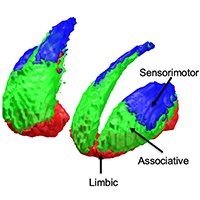Striatal topographical organization: Bridging the gap between molecules, connectivity and behavior

Accepted: 7 September 2021
HTML: 16
All claims expressed in this article are solely those of the authors and do not necessarily represent those of their affiliated organizations, or those of the publisher, the editors and the reviewers. Any product that may be evaluated in this article or claim that may be made by its manufacturer is not guaranteed or endorsed by the publisher.
Authors
The striatum represents the major hub of the basal ganglia, receiving projections from the entire cerebral cortex and it is assumed to play a key role in a wide array of complex behavioral tasks. Despite being extensively investigated during the last decades, the topographical organization of the striatum is not well understood yet. Ongoing efforts in neuroscience are focused on analyzing striatal anatomy at different spatial scales, to understand how structure relates to function and how derangements of this organization are involved in various neuropsychiatric diseases. While being subdivided at the macroscale level into dorsal and ventral divisions, at a mesoscale level the striatum represents an anatomical continuum sharing the same cellular makeup. At the same time, it is now increasingly ascertained that different striatal compartments show subtle histochemical differences, and their neurons exhibit peculiar patterns of gene expression, supporting functional diversity across the whole basal ganglia circuitry. Such diversity is further supported by afferent connections which are heterogenous both anatomically, as they originate from distributed cortical areas and subcortical structures, and biochemically, as they involve a variety of neurotransmitters. Specifically, the cortico-striatal projection system is topographically organized delineating a functional organization which is maintained throughout the basal ganglia, subserving motor, cognitive and affective behavioral functions. While such functional heterogeneity has been firstly conceptualized as a tripartite organization, with sharply defined limbic, associative and sensorimotor territories within the striatum, it has been proposed that such territories are more likely to fade into one another, delineating a gradient-like organization along medio-lateral and ventro-dorsal axes. However, the molecular and cellular underpinnings of such organization are less understood, and their relations to behavior remains an open question, especially in humans. In this review we aimed at summarizing the available knowledge on striatal organization, especially focusing on how it links structure to function and its alterations in neuropsychiatric diseases. We examined studies conducted on different species, covering a wide array of different methodologies: from tract-tracing and immunohistochemistry to neuroimaging and transcriptomic experiments, aimed at bridging the gap between macroscopic and molecular levels.
How to Cite

This work is licensed under a Creative Commons Attribution-NonCommercial 4.0 International License.
PAGEPress has chosen to apply the Creative Commons Attribution NonCommercial 4.0 International License (CC BY-NC 4.0) to all manuscripts to be published.
Similar Articles
- V. Di Felice, G. Zummo, Stem cell populations in the heart and the role of Isl1 positive cells , European Journal of Histochemistry: Vol. 57 No. 2 (2013)
- Francesca Diomede, Soundara Rajan Thangavelu, Ilaria Merciaro, Monica D'Orazio, Placido Bramanti, Emanuela Mazzon, Oriana Trubiani, Porphyromonas gingivalis lipopolysaccharide stimulation in human periodontal ligament stem cells: role of epigenetic modifications to the inflammation , European Journal of Histochemistry: Vol. 61 No. 3 (2017)
- Carolina Pellegrini, Vanessa D'Antongiovanni, Chiara Ippolito, Cristina Segnani, Luca Antonioli, Matteo Fornai, Nunzia Bernardini, From the intestinal mucosal barrier to the enteric neuromuscular compartment: an integrated overview on the morphological changes in Parkinson’s disease , European Journal of Histochemistry: Vol. 65 No. s1 (2021): Special Collection on Advances in Neuromorphology in Health and Disease
- C. Cui, P. Lal, S. Master, Y. Ma, T. Baradet, Z. Bing, Expression of parafibromin in major renal cell tumors , European Journal of Histochemistry: Vol. 56 No. 4 (2012)
- Yao Le, Zhijun Wang, Qian Zhang, Ling Miao, Xiaohong Wang, Guorong Han, Study on the mechanism of Shenling Baizhu powder on the pathogenesis of pregnancy complicated with non-alcoholic fatty liver, based on PI3K/AKT/mTOR signal pathway , European Journal of Histochemistry: Vol. 68 No. 3 (2024)
- FM Tranquilli Leali, M Artico, S Potenza, C Cavallotti, Age-related changes of monoaminooxidases in rat cerebellar cortex , European Journal of Histochemistry: Vol. 47 No. 1 (2003)
- Simone Carotti, Giuseppe Perrone, Michelina Amato, Umberto Vespasiani Gentilucci, Daniela Righi, Maria Francesconi, Claudio Pellegrini, Francesca Zalfa, Maria Zingariello, Antonio Picardi, Andrea Onetti Muda, Sergio Morini, Reelin expression in human liver of patients with chronic hepatitis C infection , European Journal of Histochemistry: Vol. 61 No. 1 (2017)
- Andrea Diana, Marcella Reguzzoni, Terenzio Congiu, Antonio Rescigno, Federica Sollai, Mario Raspanti, The byssus threads of Pinna nobilis: A histochemical and ultrastructural study , European Journal of Histochemistry: Vol. 61 No. 4 (2017)
- G Giuffrè, V Barresi, A Catalano, A Cappiello, F Stagno d’Alcontres, G Tuccari, Actinic keratosis associated with squamous and basal cell carcinomas: an evaluation of neoplastic progression by a standardized AgNOR analysis , European Journal of Histochemistry: Vol. 52 No. 1 (2008)
- P. Panettiere, D. Accorsi, L. Marchetti, A.M. Minicozzi, G. Orsini, P. Bernardi, D. Benati, G. Conti, A. Sbarbati, The trochanteric fat pad , European Journal of Histochemistry: Vol. 55 No. 2 (2011)
<< < 6 7 8 9 10 11 12 13 14 15 > >>
You may also start an advanced similarity search for this article.

 https://doi.org/10.4081/ejh.2021.3284
https://doi.org/10.4081/ejh.2021.3284










